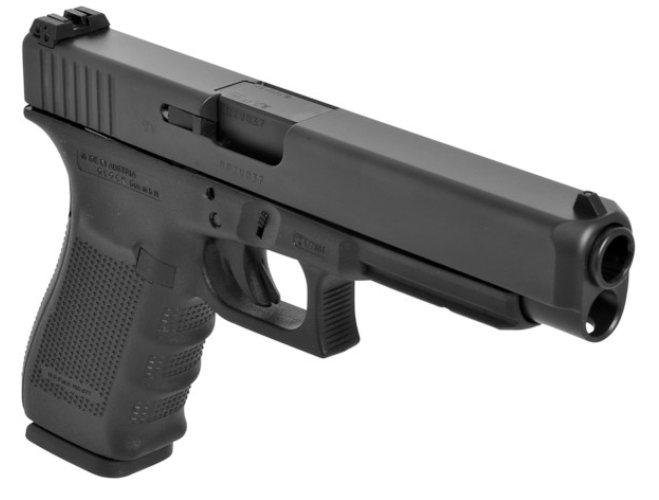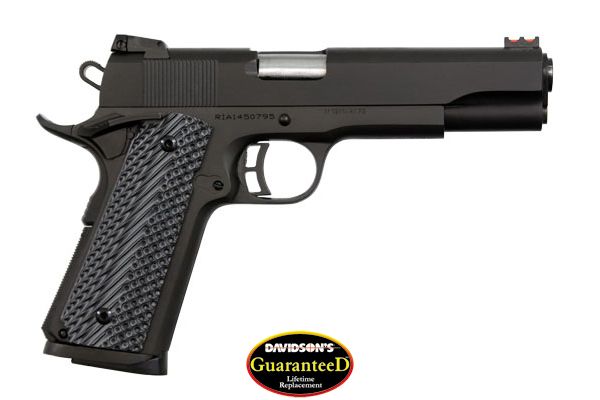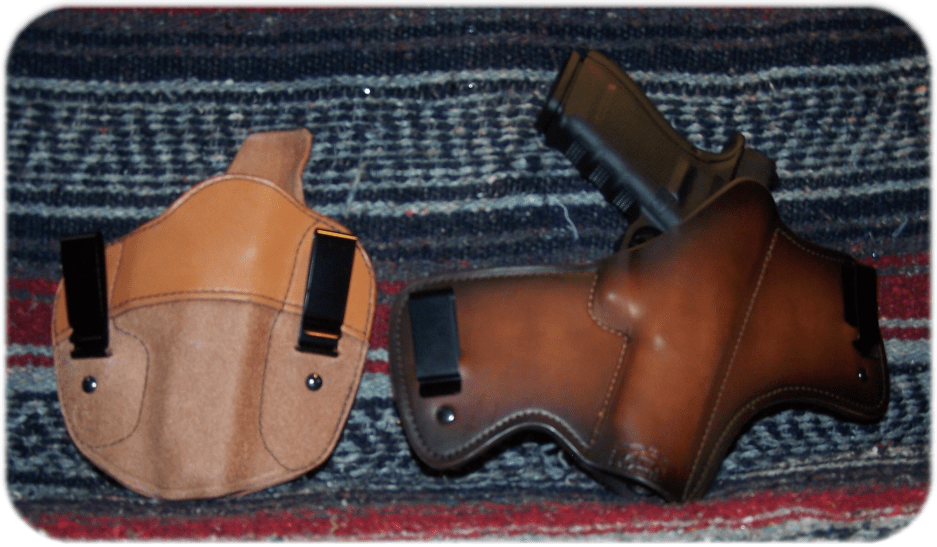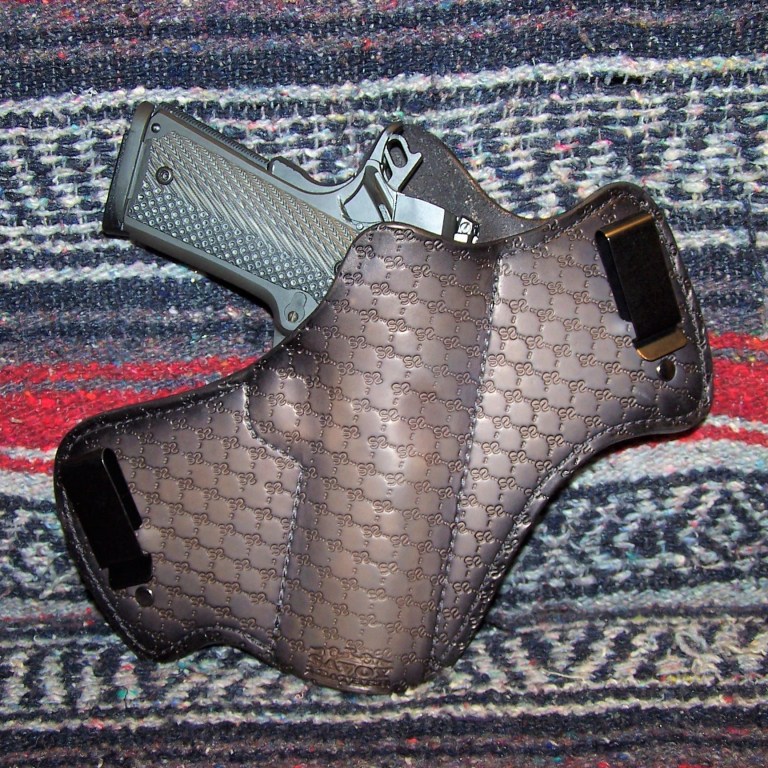I am a 1911 type of guy, and I really like the .45 ACP cartridge for defensive use. As I consider other pistol platforms to review, the thought that a most excellent pistol other than a 1911 could replace my beloved 1911 always enters my mind. I have been fortunate enough to review, shoot, and own quite a few firearms from single-shot black powder pistols to black powder revolvers, old west cartridge conversion reproductions in single action, modern single-action and double action revolvers, long guns and short guns of various platforms and styles. Still, the 1911 has remained in the forefront for me as not only a defensive tool that I carry nearly every day, but just for the all-around enjoyment of firing the 1911 in a variety of calibers, although .45 ACP and 9 mm are the dominant calibers.
Recently, I have found a pistol that has come very close to challenging the 1911 in .45 ACP for top IWB carry spot; the Glock G41 (GEN 4).

The Glock G41 is a competition-grade pistol chambered in .45 ACP that is known for its long-slide design and low profile.
It’s significantly thinner than the G21 and just like the rest of the GEN 4 models, the G41 has adjustable backstraps, improved grip texture, and the dual recoil spring system that makes it an incredibly easy gun to manage.
The G41 is an all-around great gun to have and shoot. It comes with a 13 + 1 capacity and its longer design gives the gun a great balance, which in turn improves its shootability.
The detail:
- L x W x H: 8.90” x 1.28” x 5.47”
- Barrel Length: 5.31”
- Weight: Unloaded; 27 oz (1 lb. 11 oz), Loaded (13-round); 36.51 oz (2 lb. 4.51 ounces)
- G41 (GEN 4) = $716.00 (source: Davidsons Gun Genie)
Given the relative MSRP of the Glock G41 (GEN 4) of $716.00 through Davidsons Gun Genie, a search for a comparably-priced 1911 for comparison resulted in several choices.
Because of the features that I desire on a 1911-based pistol, I chose the ARMSCOR (Rock Island Armory) M1911-A1 ROCK Ultra FS at an MSR of $725.00 (Davidsons Gun Genie). The cost is not out of the range of most gun consumers, it is comparable with the cost of the G41, and the pistol has many ‘up-to-date’ features that makes it a viable choice.

In general, the 1911 Government Model, chambered in .45 ACP, is a combat proven pistol that is known for its design and low profile.
The 1911 Government Model is slimmer than the Glock G41, but only has a 7+1 or 8+1 capacity (depending on manufacturer and user’s choice of magazines).
The 1911 Government Model is an all-around great gun to have. In full-steel form, the 1911 is heavy, which in turn improves its shootability in respect to recoil management. In specific, the ARMSCOR (Rock Island Armory) M1911-A1 ROCK Ultra FS basic details are:
- L x W x H: 8.75” x 1.3125” x 5.5”
- Barrel Length: 5.00”
- Weight: Unloaded; 39.84 oz (2.49 lbs.), Loaded (8-round); 45.736 oz. (2 lb. 13.73 oz.)
- MSRP: $725 (source – Davidsons Gun Genie)
Both the Glock G41 and 1911 Government Model platforms offer many advantages to a shootist who is willing to train with these pistols until their operation becomes second nature. Personally, I do not consider either pistol as an “entry level” pistol; that is, a pistol that I would recommend to a “neophyte” shootist.
To make this evaluation as fair as possible, and realizing that I am comparing apples to oranges, the only leveling of the playing field was to compare the Glock G41 to a comparably-priced Government Model 1911 variant. Glock “Perfection” comes at a price, and what you get for the money is, well, a Glock pistol, and Gaston and company does not give much leeway in pricing. The 1911, on the other hand, can vary widely in price, features, and quality right out of the box and dealers can give as much or as little in cost as they desire.
The main point of this comparison is that I once read an article that begged the question; “Would the Glock G41 be enough pistol to pull an advocate of the 1911 away from carrying one as an EDC?” I find that a fascinating question, since I am an advocate of the 1911 and it is my choice of EDC at any time of the year. I am also beginning to really appreciate Glock pistols for what they are.
I prefer full-size handguns. I prefer a full size (Government Model) all steel 1911, simply because I am a dinosaur and prefer an old school approach to self-defense. However, that is not to say that I prefer a classic M1911A1 pistol to defend myself. I do like and enjoy the many advancements that have taken place to make the original design of the 1911 pistol more useful. Things like Beaver-tail grip safeties, better sights, ambidextrous thumb safeties, full-length guide rods, thoughtful and tasteful design improvements, and better manufacturing processes are all welcome in my world. These, coupled with better and more effective .45 ACP ammunition, makes the 1911-based pistol a much sought-after tool.
Admittedly, there is another pistol that could have been thrown into the mix; the Springfield XDm 5.25 in .45 ACP. However, due to several of its characteristics, and as fine of characteristics as they are, I decided not to include it because it fails to be, in my opinion, a viable IWB option for all-season carry, although I have to say that it is one fine pistol for competition or defensive use. IWB carry is the main premise that I wanted understood in this article. For OWB open carry, I would select virtually any large pistol or revolver. Being able to adequately conceal a large pistol or revolver in an IWB holster narrows the field immensely. Again, IWB carry requires some considerations that OWB carry does not. The reason behind this article was to identify two possible large frame .45 ACP pistols that could vie for IWB carry that would appeal to the two most popular platforms on the market; the polymer, striker-fired crowd and the traditional 1911 crowd. While you may argue the firearms chosen, would it be hard to argue the premise upon which they were chosen? In fact, a CZ 97B or EAA Witness would make a good argument to replace the 1911; however, I really needed to compare the Glock G41 Gen4 and a 1911.
With the advent of the Glock G48, a single-stack 9 mm option, I also thought of producing an article on it in comparison to a “Commander” 1911 in 9 mm, or a G34 in comparison to a comparably-priced “Government” 1911 in 9mm, but that may come later. For now, I just wanted to concentrate on the .45 ACP chambering options. So, let’s look at the two pistols in question; the Glock G41 (GEN 4) and the Rock Island Armory M1911-A1 ROCK Ultra FS.
The Glock G41 is a polymer-framed, short recoil-operated, locked-breech semi-automatic pistols designed and produced by Austrian manufacturer Glock Ges.m.b.H. for the purpose of competition and as a “Practical/Tactical” pistol. The Rock Island Armory M1911-A1 ROCK Ultra FS is part of a product line of single-action recoil operated, ordnance grade 4140 steel constructed semi-automatic pistols. The Rock Island Armory M1911-A1 ROCK Ultra FS is designed and manufactured by ARMSCOR in Marikina, Philippines, and distributed in the United States by ARMSCOR USA, located in Pahrump, Nevada.
The Glock G41 would normally be considered as a “Service-Size” pistol, as would be the Rock Island Armory M1911-A1 ROCK Ultra FS. The Glock G41; and more so the Glock G21, would be considered a pistol found in a duty holster of law-enforcement officer gun belts; whereas, the Rock Island Armory M1911-A1 ROCK Ultra FS would never be found in such, because it is more in tune with civilian “duty” needs as a defensive tool. That is not to say; however, that a 1911 variant is not found in duty holsters of law enforcement and government personnel. Au contraire, mon ami! “Old Slabsides” is still called upon when the time to deliver the mail is essential.
While the G41 has features that are indigenous to the Glock platform, the Rock Island Armory M1911-A1 ROCK Ultra FS has features found on more expensive 1911-based pistols.
The Glock G41 lacks a grip (sometimes called a ‘palm’) and thumb safety; whereas, these are standard features on any 1911-based pistol, although these features are “enhanced” with the Rock Island Armory M1911-A1 ROCK Ultra FS in that a memory bump is used with the grip safety to ensure positive engagement, and the thumb safety is enlarged and ambidextrous.
The Glock G41 incorporates a trigger safety that prevents the pistol from firing should the trigger finger not be centered on the trigger. A drop safety is also incorporated into the Glock’s design that prevents the pistol from discharging should the pistol be dropped. The Rock Island Armory M1911-A1 ROCK Ultra FS has no such safeties, as the thumb and grip safeties offer adequate protection against ND (Negligent Discharge) when used in conjunction with the universal gun safety law of keeping the trigger finger off the trigger until ready to fire.
The availability of sights on the Glock G41 differ; a standard Glock polymer sights, Glock steel sights, Glock polymer adjustable rear sight, or Glock Night Sights (GNS). While my Glock G41 was unavailable with GNS (something that I like for defensive use), I was able to have a set of GNS installed at the Glock facility in Smyrna, Georgia. The Rock Island Armory M1911-A1 ROCK Ultra FS comes with a Dovetail Fiber-Optic Front Sight and LPA MPS1-Type Adjustable Rear Sight. This setup is adequate for most lighting conditions.
The grip of the Glock G41 (GEN 4) is adjustable using inserts; two of which are standard inserts and two of which are “beaver-tail” inserts. I opted to install the largest of the “beaver-tail” inserts that provided an excellent trigger-reach for my hands. Roughly speaking, the grip of the Glock G41 (GEN 4) can be adjusted from SF (short frame) to LF (large frame) to accommodate different size hands. The grip texture is what Glock labels as RTF (Rough Texture Frame); however, I find the texture to be just right for my hand. It is present on the frame as well as on the interchangeable backstraps. The Rock Island Armory M1911-A1 ROCK Ultra FS comes with nicely textured VZ composite grips that provide excellent gripping characteristics without being (too) obtrusive to the hands. The grip panels blend well into a beveled magazine-well extension that allows an eight-round magazine to be flush with the mag well. Because of the mag-well type, the grip panels cannot be easily changed without extensively modifying the replacement grip panels, which means the user is pretty much stuck with the existing grip panels. The back strap is textured with the front strap to be complete with vertical serrations. I find the grip of the Rock Island Armory M1911-A1 ROCK Ultra FS to be very familiar in feel to most modified 1911-based pistols. Note; however, that I would not carry the Rock Island Armory M1911-A1 ROCK Ultra FS without an inner shirt, as the G10 grips would seriously aggravate the skin. Since I always wear a “T” skin abrasion is not an issue.
The trigger of the Glock G41 (GEN 4) is excellent, but different from a standard trigger as would be found on a Glock G19, for example. As I get more used to the Glock trigger, I find that I am better able to “roll” the trigger rearward rather than stopping at “the wall” and pulling rearward from there. There is no “wall” per se, and the trigger progresses smoothly through the take-up to striker release transition. The average trigger pull on this unit is 3 pounds 15.1 ounces. The trigger on the Rock Island Armory M1911-A1 ROCK Ultra FS is excellent for a 1911-based pistol in this price range. Since the Rock Island Armory M1911-A1 ROCK Ultra FS is built on the “Series 70”, the trigger pull is not affected by hammer block components, rolls smoothly through the take-up, exhibits a crisp 4.75-pound trigger pull, with no over-travel (adjustable). After some break-in time, the triggers on both the Glock G41 and the Rock Island Armory M1911-A1 ROCK Ultra FS really come into their own and both are a pleasure to use.
The barrel of the Glock G41 is the longer of the two pistols at 5.3-inches, as compared to the Rock Island Armory M1911-A1 ROCK Ultra FS’s barrel of 5-inches. But this little difference does not equate to extreme greater velocity nor clearing a holster faster. However, carrying a pistol of substantial barrel length does mean more barrel is hidden when the pistol is carried IWB, which leaves the grip as the challenge to conceal. However, a longer barrel does require a holster design that will prevent the holster (and pistol) from riding up when sitting.
Surprisingly, the grip length of the Glock G41 is almost the same as the Rock Island Armory M1911-A1 ROCK Ultra FS. Also, as surprisingly, is the fact that the grip width is not that great between the two pistols; albeit the grip width of the G41 is slightly wider. The grip angle of both would probably come more into play over the grip width. In my opinion, the grip angle of the 1911 pistols is more natural than that of the Glock pistol – any Glock pistol and is the reason that the 1911 pistol, when gripped properly, is a natural pointer.
Now, on to the weight of the two pistols. One would think that because the Glock G41 (GEN 4) is predominantly polymer that the G41 would be substantially lighter than the Rock Island Armory M1911-A1 ROCK Ultra FS. Not so fast there Sparky! The actual result is that the G41 is only around 0.6 ounces lighter than the fully loaded Rock Island Armory 1911 FS Tactical. However, the G41 carries 13+1 .45 ACP cartridges as compared to the 8+1 capacity of the Rock Island Armory M1911-A1 ROCK Ultra FS. While the definite advantage in capacity goes to the Glock G41, a price is still paid in the weight department with regard to carrying the darn thing.
One thing that I would like to touch on is choice of finishes available for the Glock G41. The slide of the G41 GEN4 comes in one finish – black Tennifer (Author’s Note: At the time of this writing, the GEN4 is the latest version. If a GEN5 version becomes available, it may follow the other GEN5 pistols in using the nDLC finish, which is a tougher and more durable finish that is exclusive to the GLOCK manufacturing process.). The Rock Island Armory M1911-A1 ROCK Ultra FS comes in a Parkerized finish on both slide and frame. Both finishes do well to protect the firearm.
I cannot say that the Glock G41 (GEN 4) is the more accurate of the two pistols; both are more than adequate in the accuracy department given that the ammunition selected for each pistol is the best for the pistol. For example, Sig Sauer V-Crown 230-grain JHP is highly accurate in the Rock Island Armory M1911-A1 ROCK Ultra FS, but not as accurate in the Glock G41 (GEN 4). In fact, I am still working on ammunition that I find acceptable to shoot through the G41 for defensive purposes. Additionally, and what is interesting, is that because the Glock G41 (GEN 4) weighs approximately the same (2.282 pounds (36.51 ounces) fully loaded) as the Rock Island Armory M1911-A1 ROCK Ultra FS, felt recoil is about the same between the two pistols. In fact, the felt recoil of the G41 may be somewhat less due to the polymer frame construction, which tends to absorb some of the recoil. However, the Rock Island Armory M1911-A1 ROCK Ultra FS weighs 2.87 lb. (45.92 ounces) fully loaded and 2.49 lb. (39.84 ounces) unloaded is still the heavyweight, loaded or not. I don’t know about you, but I don’t carry a firearm unloaded when I am out among the English. And, I am used to the weight of an all-steel 1911-based pistol being on my hip and in my hand. The difference in the fully loaded weight of the G41 and the Rock Island Armory M1911-A1 ROCK Ultra FS is negligible for all practical purposes.
Let’s look at portability and concealability of these two very large pistols. These are not pocket or tuxedo firearms and; therefore, need special consideration.


In most cases, the only difference in my manner of dress when carrying concealed is how many outer garments are worn. It’s July here in Georgia, and we are topping out at mid to high 90 degrees already. For most folks, this is shorts and t-shirt weather. For this old man, it is jeans or cargo pants, colored t-shirt, a long sleeve outer shirt, and a baseball hat of some kind. For my outer shirt, I prefer the denim work shirts from Dickie’s. My dress is work casual. Unless I am meeting with customers, my manner of dress is the same at work as it is away from work. The major difference is that when I am not at work, a 1911 is usually tucked in an IWB holster just off the right hip. I wear the holster as tight to the body as possible and at an angle that helps to hide the butt of the pistol. My trousers are one size larger than I would normally wear. My shirts are two sizes larger than I would normally wear. My shirt are unbuttoned to allow the greatest movement and fast access to my firearm, if needed. In short, I dress as conservative as possible and without drawing attention to myself. If a situation dictates that I need to carry a smaller firearm, I adjust as needed. But, in most cases I find myself carrying a full-size 1911-based pistol with rare excursions with a “Lightweight Commander” 1911 in a shoulder holster or a full size 1911 in a vertical shoulder holster when traveling. The clothing selection; however, stays the same should I need to transition from “travel carry” to “normal carry” mode.
Closing it Up
Have I answered whether the Glock G41 would be a viable choice for switching from a 1911-based pistol in .45 ACP offering? I don’t know if I have or not. What I can say is that I am comfortable carrying either pistol. While they are different platforms, both can serve me well keeping bad people, who are intent in doing harm on me and mine, have a life-changing event. I am not a LEO anymore; therefore, I need not show my hand until it needs to be shown. I need not throw myself into situations that could be disruptive to my lifestyle, but if that situation arises, I know that I will have the tools to stop any threat, and that they will only be detected when they are needed.
If you prefer carrying a large handgun in a major caliber, I can recommend both the Glock G41 and a 1911-based full-sized pistol. The only thing common to these two pistols is the caliber. Neither are entry-level firearms, and both require a degree of training to fully master. There are, of course, other offerings in .45 ACP “duty” pistols that can meet your needs. I was only comparing two models that, for me, fit my needs for a defensive handgun.
Resources:
- Glock GEN4 G41 – Is Longer and Slimmer Better?: https://guntoters.com/blog/2019/01/06/glock-gen4-g41-is-longer-and-slimmer-better/
- A Tale of Frik and Frak RIA Rock Ultra 1911A1 (TAC II) FS and MS Model: https://guntoters.com/blog/2018/04/13/a-tale-of-frik-and-frak/
- Glock G41 GEN4: https://us.glock.com/en/pistols/g41-gen4
- Rock Island Armory 1911 Ultra FS: https://armscor.com/firearms/ria/rock-series/rock-ultra-fs-45-acp/
![]()

